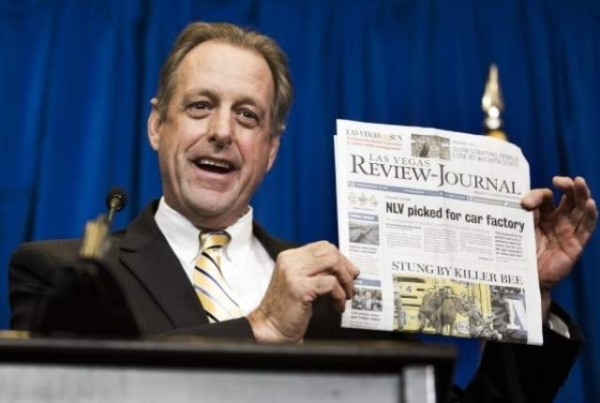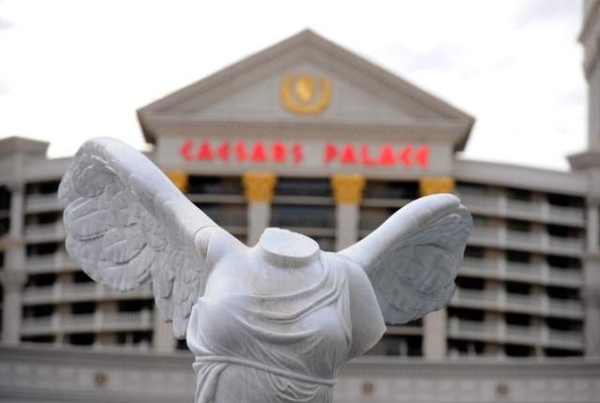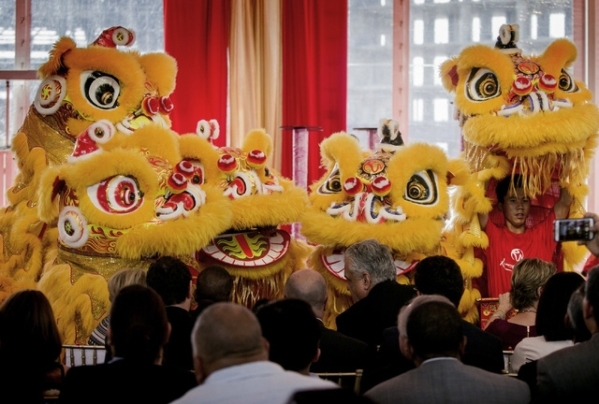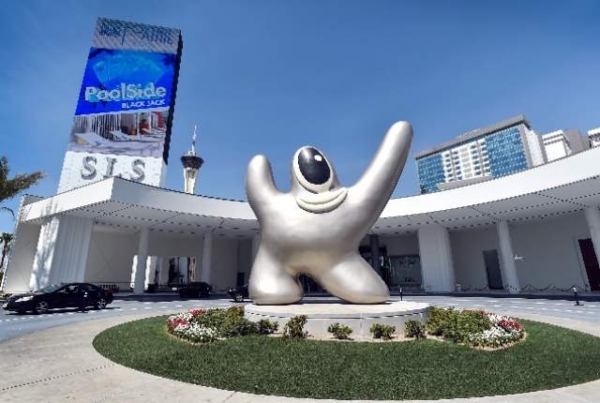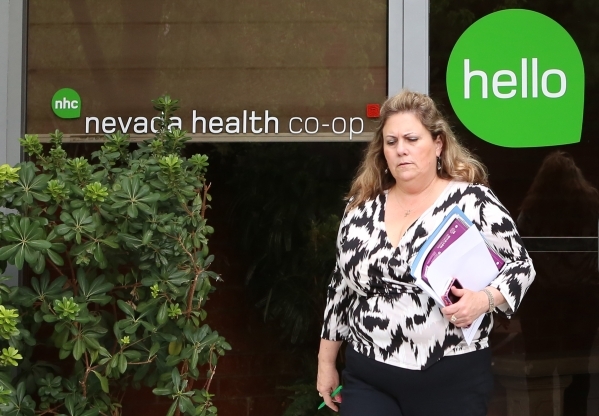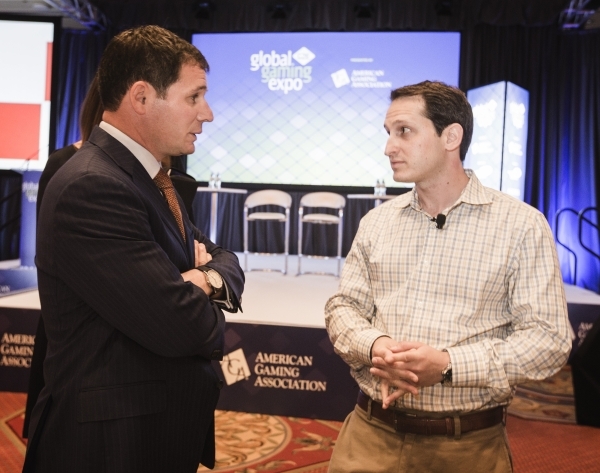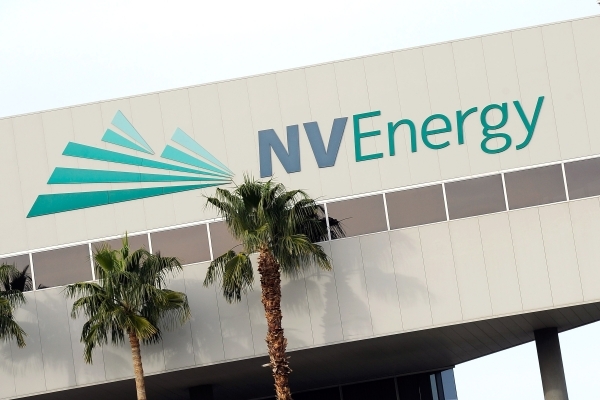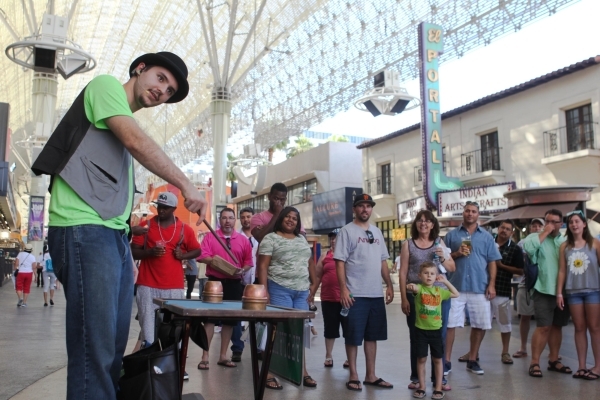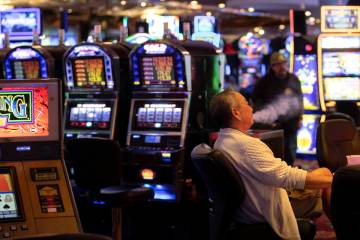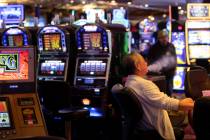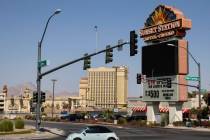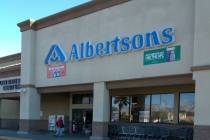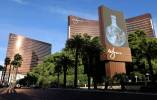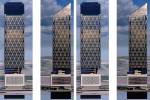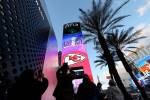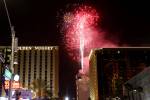Nevada landing car factory is top business story of 2015
Flash back to January 2015. Imagine someone saying that that North Las Vegas would land a major car-manufacturing plant. And that the Las Vegas Review-Journal would be sold — not once, but twice.
Surprised? Perhaps.
Other major stories developed throughout the year. There were bankruptcy struggles for a unit of Caesars Entertainment. Major resorts were promised for the Strip. And the north Strip continued to struggle.
Here's the list of 10 major business stories for 2015.
1. State lands car company
The public never knew it, but throughout 2015, North Las Vegas and state officials were secretly meeting with representatives of an electric car company that hopes to introduce a high-tech vehicle to compete with the popular Tesla Model S.By fall, it was apparent Nevada was among the states with a chance to become the new home of a $1 billion, 3 million-square-foot manufacturing plant for Faraday Future.In mid-December, Gov. Brian Sandoval announced that the Governor's Office of Economic Development's efforts had paid off and that the Apex Industrial Park would become the new home of Faraday's automotive factory. The state beat out California, where Faraday already has a research-and-development facility, and Georgia and Louisiana, which have a robust car manufacturing economy.The state quickly convened a special session of the Legislature to draft bills that would outline economic incentives that would be offered to California-based Faraday to build in Southern Nevada.Faraday hopes to break ground on the new plant by the first quarter of 2016 and produce its first car by the end of 2017.The company plans to unveil its concept just before next month's International Consumer Electronics Show in Las Vegas.
— Richard N. Velotta
2. Media owners change
Maybe it didn't significantly affect the news you consume, but all of Southern Nevada's big media outlets changed ownership in the last year as major corporations or their executives scooped up TV stations and newspapers alike.
From November 2014 to April, Maryland-based Sinclair Broadcast Group, which already owned KVCW and KVMY, added KSNV-TV, Channel 3, to its portfolio for $120 million; Nexstar Broadcasting Group of Texas bought KLAS-TV, Channel 8, for $145 million; and E.W. Scripps Co. of Ohio purchased KTNV-TV, Channel 13, for an undisclosed price.
The Las Vegas Review-Journal in particular endured musical chairs — it was sold twice from March to December.
GateHouse Media, a subsidiary of New York-based New Media Investment Group, bought the RJ's parent company, Stephens Media, in March for $102.5 million. The deal included the RJ, plus seven other daily newspapers and 65 weekly publications in seven states.
But GateHouse flipped the RJ on Dec. 7 to the family of billionaire casino owner Sheldon Adelson. The family, which created News + Media Capital Group LLC to buy the RJ, spent $140 million for the paper. They didn't disclose their purchase for nearly a week, causing a national media firestorm over transparency.
Observers speculated about the family's motives in buying a lone newspaper for a price that equaled seven times the paper's cash flow — about twice the industry norm
The Adelsons said in a statement that their motivation was "simple."
"We believe in this community and want to help make Las Vegas an even greater place to live. We believe deeply that a strong and effective daily newspaper plays a critical role in keeping our state apprised of the important news and issues we face on a daily basis. ... The family wants a journalism product that is second-to-none and will continue to invest in the paper to achieve this goal."
The RJ reported a week after the sale that its reporters were directed to spend time in the courtroom of a District Court judge presiding over a high-profile wrongful-termination case involving Sheldon Adelson's Las Vegas Sands Corp. The article caused additional scrutiny on the deal, the details of which are still unfolding.
— Jennifer Robison
3. Debt overwhelms Caesars
No one was surprised that Caesars Entertainment Corp. turned to the U.S. Bankruptcy Court in January for help in unraveling the casino company's complicated financial structure.
Caesars placed its largest operating division — Caesars Entertainment Operating Co. — into a Chapter 11 reorganization with plans to eliminate almost $10 billion of the business unit's $19.6 billion in debt. The plan is to convert the operating division into a real estate investment trust with Caesars continuing to operate the properties.
Caesars has a gaming industry-high $22.6 billion in long-term, which came from a $30.7 billion leveraged buyout by private equity firms TPG Capital and Apollo Global Management in 2008. The company has spent years trying to manage the debt.
The operating division includes Caesars Palace, Caesars Atlantic City, Harrah's Reno and more than a dozen regional properties.
Caesars said 80 percent of the company's first-lien creditors, representing $12 billion of debt, have signed off on the plan.
The casino operator sought additional time from the court to work out an agreement with second-tier lenders who have not signed on to the restructuring. But lawsuits filed before and after the bankruptcy have slowed the process.
On the day it filed the reorganization, Caesars said business operations would continue normally at its properties.
But several former Caesars Entertainment employees lost their retirement income because of the bankruptcy restructuring. The employees were told the company no longer would make payments under a supplemental employee retirement plan that was tied to the operating division.
Meanwhile, a month after the bankruptcy filing, Caesars Chairman and CEO Gary Loveman announced his intentions to cede the CEO position in June. He was replaced by Mark Frissora, a former CEO of Hertz Global Holdings.
— Howard Stutz
4. Strip projects awaited
When Genting Berhad bought the stalled Echelon site in March 2013, officials from the Malaysia-based company said they hoped to proceed as soon as possible on a project the company dubbed Resorts World Las Vegas.
As 2016 arrives, the gaming industry still awaits the full-blown construction project, which is expected to top $4 billion.
In May, Genting held a ceremonial groundbreaking for the development while a construction team completed the property's parking garage. Since then, it has been silence.
Genting executives and the company were found suitable by Nevada gaming regulators in 2014 — a notch short of full-fledged licensing — but the construction hammers have been quiet.
Meanwhile, it was also quiet a little way down the Strip, where few details emerged about a 35-acre Strip site that a group — Australian billionaire James Packer, former Wynn Resorts Ltd. executive Andrew Pascal and investment firm Oaktree Capital — acquired in July 2014.
In July the name surfaced — Alon — in paperwork field with Clark County seeking land entitlements and permits for the site, where the New Frontier once stood. A few early renderings were released with plans calling for an 1,100-room hotel over two towers. An analyst this month estimated the Alon budget at $1.9 billion.
Site work has begun on the vacant lot.
2016 could bring the coming-out parties for both Strip developments
— Howard Stutz
5. North Strip struggles
It wasn't the best of years for the Strip's north end.
The Rat Pack-era Riviera ended a 60-year run, closing in April after the building was bought by the Las Vegas Convention and Visitors Authority for $182.5 million. The agency aims to demolish the building and build a convention center complex on the site as part of its planned $2.3 billion Global Business District. The demolition is not expected until early 2016.
Meanwhile, the unfinished Fontainebleau, mothballed since 2009, went on the market when CBRE Las Vegas listed hulking structure for $650 million. The once-planned $3 billion development was 70 percent completed when developers ran out of money. Billionaire corporate raider Carl Icahn bought the tower out of bankruptcy in January 2010 for $150 million but has done nothing with site other than to sell off furnishings and building materials.
In November, Icahn and Clark County agreed to have the investor wrap 10 stories of the tower's west side in paint and fabric to hide rusty building panels from Strip view. Work on the cover is scheduled to finish in mid-2016.
Then there is the SLS Las Vegas.
The 16-month-old property — a $415 million renovation of the Sahara — bled money in 2015, reporting losses of $122.7 million in the first nine months of the year, filings with the Securities and Exchange Commission show. In November, Stockbridge Capital Partners, which owned 90 percent of the SLS, acquired the 10 percent stake held by Sam Nazarian through his Los Angeles-based SBE Entertainment.
Nazarian was considered the visionary behind the SLS Las Vegas, having led the purchase of the Sahara in 2007 and having overseen the redesign.
Under the agreement, Stockbridge will pay a licensing fee to SBE for the SLS name and the property's restaurant brands that are owned by the company.
For the year, Stockbridge has contributed almost $59.3 million to the SLS operations.
Also in November, Stockbridge announced a deal with lodging giant Starwood Resorts Worldwide to convert the property's 289-room Lux tower, one of three hotel towers at the SLS, into the W Las Vegas. The separate, nongaming hotel will open by September.
— Howard Stutz
6. Obamacare insurer closes
An idealistic attempt to inject competition into local health insurance markets fell short of its mission in late summer.
Nevada Health CO-OP, a nonprofit insurer created by the Affordable Care Act and federally funded to offer coverage through the Nevada Health Link marketplace, said in August that it couldn't stay in business past Dec. 31, as a second year of high claims costs and poor enrollment projections would take too much of a financial toll.
Observers say the CO-OP, as idealistic as its origins were, could not survive market realities amid early troubles with doctor networks, reimbursements, off-exchange coverage and administrative costs.
Financial statements showed the carrier struggling to make money.
The nonprofit reported a $19.3 million operating loss in 2014 and a $3.5 million first-quarter loss through March, according to Centers for Medicare and Medicaid Services records. From January through June, it lost $22.7 million.
The closure dropped Nevada Health Link's Clark County carrier base from five to four, including market giants UnitedHealth and Anthem, which already combined for more than 90 percent of the state's privately insured residents.
A third carrier, Prominence, plans to expand from Northern Nevada into Southern Nevada. Humana will also offer two local plans on the exchange for 2016.
In the meantime, the CO-OP's members can move into new plans during open enrollment, which continues through Jan. 31.
7. Tourism shines
Tourism in Southern Nevada was never better than in 2014 — except possibly in 2015.The Las Vegas Convention and Visitors Authority announced in January what most industry observers knew a month earlier — that more tourists came to Southern Nevada in 2014, 41.1 million, than any year in history.When the total was confirmed, Las Vegas Convention and Visitors Authority President and CEO Rossi Ralenkotter said the new benchmark would be 45 million, but he said he didn't expect to hit that for a few years.That milestone probably won't happen in 2015, but it's virtually certain that this year will produce a record.The last monthly report issued for January through October gave the year-to-date total at 36.7 million, 2.7 percent ahead of 2014's pace.
2015's count has been strong for several reasons. Convention attendance is up 6.1 percent from 2014. Las Vegas resorts have expanded their "dayclub" pool parties. Noting the successful Electric Daisy Carnival that invades Las Vegas Motor Speedway in the summer, properties also have added outdoor festival venues and staged gatherings that have drawn fans from across the country.The Convention and Visitors Authority isn't finished developing its strategy for reaching that 45 million plateau and beyond. It has expanded its marketing plan to focus on millennial visitors, those 20-something travelers who may not gamble much, but are big-time attendees of nightclubs, dayclubs and festivals such as I Heart Radio, Rock in Rio and Life Is Beautiful.
— Richard N. Velotta
8. Fantasy sports debated
It's the debate that operators of daily fantasy sports websites never wanted to see happen.
But when every football game seemed to have a barrage of commercials from DraftKings or FanDuel, Nevada gaming regulators noticed.
Nevada gaming regulators, based on an attorney general's opinion, said in October that daily fantasy was sports wagering under the state's gambling laws. The activity wasn't illegal, but the website could not offer the activity to Nevada customers unless the companies earned gaming licenses.
New York's attorney general reached that same conclusion a month later and the activity was shut down in a market that is considered 13 percent of the overall business. DraftKings and FanDuel sued in New York and lost, but an appellate court is expected to address the issue in the new year.
DraftKings and FanDuel have been haunted by their previous deeds.
In September, DraftKings CEO Jason Robins told a Global Gaming Expo audience in Las Vegas the activity was a game of skill, similar to chess or like playing the stock market. It takes skill to make money, he said.
The sites have all but admitted they're gambling. In August, United Kingdom gaming regulators licensed DraftKings. FanDuel recently applied in the United Kingdom for a license as a "gambling software" company.
As 2016 arrives, the Washington, D.C.-based American Gaming Association plans to seek "a rational alternative" to the nation's sports wagering laws, which are limited to four states by the 1992 Professional and Amateur Sports Protection Act.
Daily fantasy sports will be included in the study.
— Howard Stutz
9. Utility sees challenges
CARSON CITY — It has been a tumultuous year for the electrical utility industry in Nevada, with large companies seeking to leave NV Energy and rooftop solar customers and solar officials fighting against a new less favorable rate structure.
It appears that NV Energy, Nevada's statewide electrical utility and part of Berkshire Hathaway, is the winner so far on both fronts.
The Nevada Public Utilities Commission earlier this month approved applications by the Las Vegas Sands Corp., MGM Resorts International and Wynn Resorts to leave Nevada Power, part of NV Energy, and secure their own energy supplies on the wholesale market.
But all three have asked the agency to reconsider the decisions. Las Vegas Sands said the PUC decision, with its $23.9 million exit fee and other conditions, "effectively denied" the exit application.
The Review-Journal is owned by a limited liability corporation owned by the family of Sands chairman and CEO Sheldon Adelson.
The PUC has 40 days to act. If it does not act, the orders remain unchanged.
NV Energy earlier this year also worked with the data storage company Switch to keep it as a customer of the utility after it sought to leave as a customer.
On the rooftop solar front, the PUC on Dec. 22 adopted a new rate for net metering that solar officials say means the death knell for the industry in Nevada.
NV Energy proposed new rates arguing that non-rooftop solar customers subsidize those with the systems. The rate review was required by the Nevada Legislature.
While rejecting a demand charge opposed by solar advocates, regulators adopted a new rate structure that will mean a higher fixed monthly charge for rooftop solar customers. The credit received for excess energy generated by rooftop systems will also shrink to wholesale rates. It is also retroactive to cover all rooftop solar customers.
Critics of the NV Energy proposal have argued it is designed to eliminate competition by Berkshire Hathaway whose CEO is Warren Buffett.
The rooftop solar battle is far from over, however, and will likely be an issue in the 2017 session of the Nevada Legislature.
— Sean Whaley
10. Downtown revenue up
Casino revenue trends helped downtown Las Vegas' recovery gain momentum in 2015.
From January to October, casino revenues were up 4.5 percent for all downtown hotel-casinos compared with the same 10 months in 2014, said Mike Lawton, senior research analyst at the Gaming Control Board.
The sole months in 2015 in which downtown casino revenue dropped from the previous year were January and October, Lawton said.
"It's been a nice, steady increase. The economy is improving," Lawton said. "Downtown has been a consistent growth all calendar year."
In 2014, downtown casino revenues increased 2.1 percent over 2013. This year's 4.5 percent increase through the end of October is more than double 2014's mark.
In comparison, casino revenue on the Strip was down 1.8 percent from January to October of 2015 over the same 10-month period in 2014, Lawton said.
Boyd Gaming Corp. casinos generated cash flow that helped fuel downtown's casino revenue uptick. The Boyd-owned casinos — Main Street Station, Fremont and California — each produced cash-flow gains for five straight quarters.
— Alan Snel



